Trees Birds Mammals Fish Amphibians Reptiles
Wild Algarve
Bookshop
Stropharia pseudocyanea (Desm.) Morgan - Peppery Roundhead
Phylum: Basidiomycota - Class: Agaricomycetes - Order: Agaricales - Family: Strophariaceae
Distribution - Taxonomic History- Etymology - Identification - Culinary Notes - Reference Sources
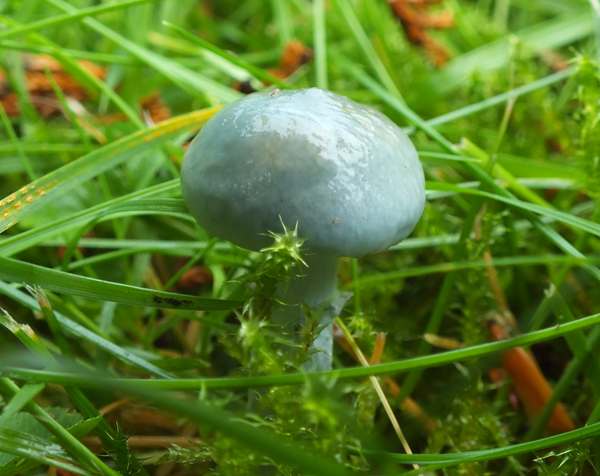
Stropharia pseudocyanea is one of very few blue-green
fungi. (In some instances the caps are nearer to green than to blue, and with age they tend to become brownish, but when young and fresh they are very beautiful and, despite their small stature, quite startling.) The caps, initially bell-shaped, flatten and turn paler from the
centre. What makes this species instantly recognisable and truly memorable is not so much its admittedly attractive appearance but its distinctive smell - exactly like freshly ground pepper..
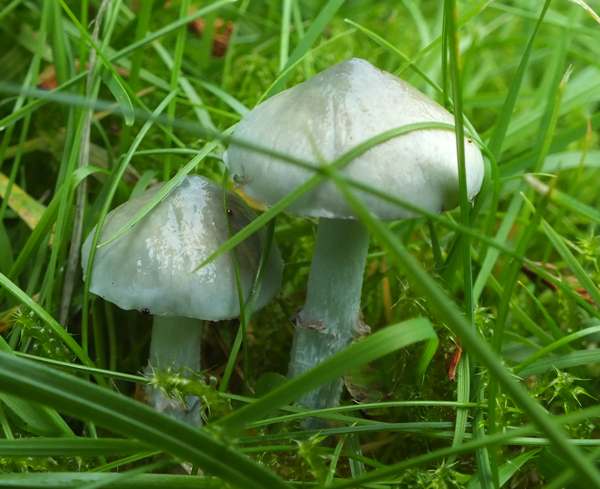
The Peppery Roundheads pictured above were found in a churchyard near Newtown, in Wales..
Distribution
Peppery Roundhead mushrooms are an occasional find throughout Britain and Ireland, occurring mainly in unimproved or semi-improved grassland. These striking mushrooms are also found in many parts of central and northern mainland Europe, and they are also recorded in western North America.
Taxonomic history
Although this little blue mushroom has been known to science for something like two centuries, its separation from Stropharia aeruginosa had not been clearly defined until it was described in a 1908 posthumous publication by American mycologist Andrew Price Morgan (1836 - 1907) and given its currently-accepted scientific name Stropharia pseudocyanea.
The basionym dates from 1823, when French naturalist John Baptiste Henri Joseph Desmazières (1786 - 1862) described this pretty little mushroom and gave it the binomial scientific name Agaricus pseudocyaneus. (In the early years of fungal taxonomy and naming, most gilled mushrooms were initially placed in the genus Agaricus, since slimmed down by transfer of the majority of former Agaricus species to other newer genera, including of course Stropharia.)
Synonyms of Stropharia pseudocyanea include Agaricus pseudocyaneus Desm., Agaricus albocyaneus Fr., Stropharia albocyanea (Fr.) Quél., Agaricus worthingtonii Fr., and Stropharia worthingtonii (Fr.) Sacc.
Etymology
Stropharia, the genus name, comes from the Greek word strophos meaning a belt, and it is a reference to the stem rings of fungi in this generic grouping. The specific epithet pseudocyanea means nearly blue, and it refers to the blue-green colouring of these grassland mushrooms.
Identification Guide
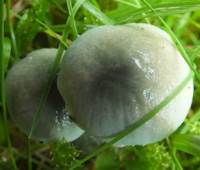 |
Cap
Young caps are initially bell-shaped but soon flatten, usually retaining an umbo and expanding to between 2 and 4cm in diameter. The cap surface is blue-green and
slimy, usually without marginal veil fragments (unlike Stropharia caerulea and Stropharia aeruginosa, which are also blue-green when young and fresh but generally much larger), turning white or pale brown with age. |
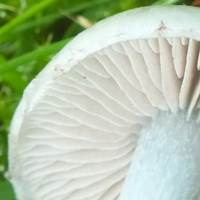 |
Gills
At first the colour of milky coffee, the crowded sinuate (notched near to the stem) gills
turn greyish brown at maturity, but the gill edges remain almost white
|
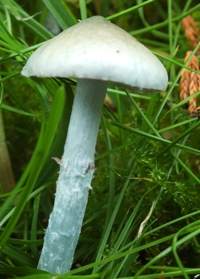 |
Stem
Whitish and fairly smooth above the ring, which is transient and soon disappears, pale and sometimes with white scales below the ring-zone. 2 to 5mm in diameter and 4 to 10cm tall.
|
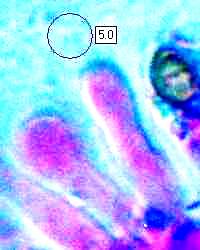 |
Cheilocystidia
Clavate, 2-7µm diameter at the apex; often slightly capitate.
|
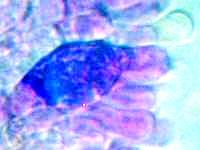 |
Pleurocystidia
Pleurochrysocystidia are clavate with a mucronate apex or occasionally lageniform.
Above: the pleurochrysocystidium shown here has been stained using PlaqSearch, which turns chrysocystidia deep blue rather than yellow (as when traditionally stained using ammonia). |
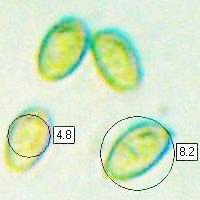 |
Spores
Ellipsoidal to ovoid, smooth, 7-10 x 4.5-5μm, without a germ pore.
Spore print
Purple-black. |
Odour/taste |
Smells strongly of freshly ground pepper . (Caution: this species might be
poisonous, so tasting is not advisable.) |
Habitat & Ecological role |
Saprobic, usually in small groups among grass in unimproved or semi-improved permanent pastures, old lawns, churchyards and parkland.. |
Season |
July to October in Britain and Ireland. |
Similar species |
Stropharia aeruginosa is a larger blue-green mushroom and its cap scales are persistent; it has reddish-brown gills with white edges. This species is uncommon in Britain and Ireland. It does not have a peppery odour.
Stropharia caerulea is a larger, fairly common blue-green roundhead without a peppery odour.
Clitocybe odora is also blue-green but does not have a slimy
cap with scales; it has a strong odour of aniseed. |
Culinary Notes
Together with other fungi in the genus Stropharia, the Peppery Roundhead is inedible and may even be poisonous. Some of the Stropharia species can certainly cause very unpleasant gastrointestinal symptoms. We therefore treat Stropharia pseudocyanea as just for looking, and definitely not for cooking.
Reference Sources
Funga Nordica: 2nd edition 2012. Edited by Knudsen, H. & Vesterholt, J. ISBN 9788798396130
BMS List of English Names for Fungi
Noordeloos, M.E. (2011). Strophariaceae s.l. Edizioni Candusso: Alassio, Italy. 648 p.
Dictionary of the Fungi; Paul M. Kirk, Paul F. Cannon, David W. Minter and J. A. Stalpers; CABI, 2008
Taxonomic history and synonym information on these pages is drawn from many sources but in particular from the British Mycological Society's GB Checklist of Fungi.
Top of page...
Fascinated by Fungi. Back by popular demand, Pat O'Reilly's best-selling 450-page hardback book is available now. The latest second edition was republished with a sparkling new cover design in September 2022 by Coch-y-Bonddu Books. Full details and copies are available from the publisher's online bookshop...